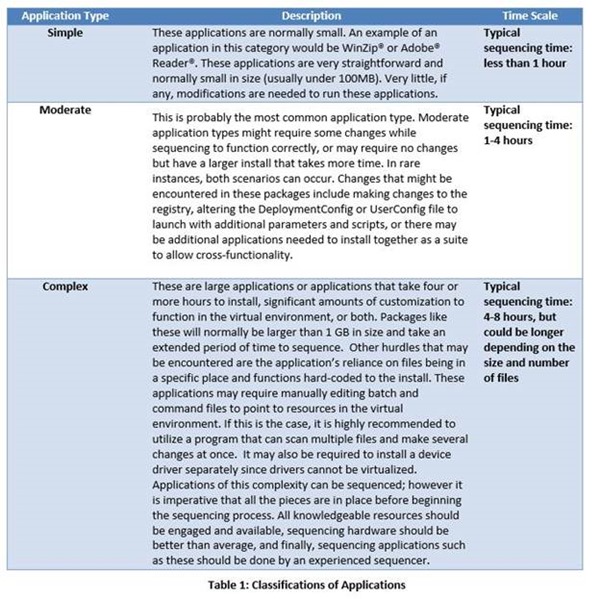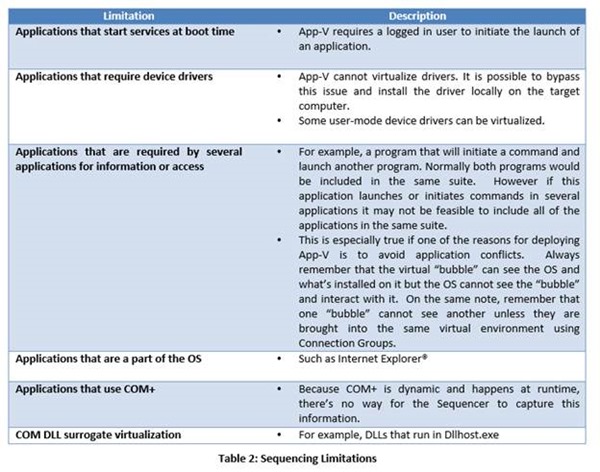Applications Suitable for Virtualizing in Microsoft Application Virtualization (App-V)
~ Chuck Timon
 A question often asked by customers is “What types of applications are suitable for virtualizing using Microsoft’s Application Virtualization (App-V) solution?” Occasionally it’s more specific where the question is “Does Microsoft publish a ‘white-list’ of applications that can be virtualized using App-V?”
A question often asked by customers is “What types of applications are suitable for virtualizing using Microsoft’s Application Virtualization (App-V) solution?” Occasionally it’s more specific where the question is “Does Microsoft publish a ‘white-list’ of applications that can be virtualized using App-V?”
When I first started supporting App-V and I had customers ask me these questions, they seemed on the surface to be perfectly reasonable, however finding the answers proved to be elusive and in the end I found that there were no definitive answers. What I soon learned is that Microsoft provides information about ‘types’ of applications that may not be suitable for virtualizing using App-V. There is no ‘white-list’ of ‘approved’ applications. And thinking more about it, this makes perfect sense. Obviously there is no way to test every possible application, and providing such a list would imply that if a vendor’s application is absent from the list then that application is not suitable for virtualizing using App-V.
I recently brought this topic to the App-V product team and after some discussion it was clear that if the product team were to dedicate development cycles to testing and verifying all third party applications then there would be no time for anything else. Ultimately the answer lies with the application vendor and individual testing of application packages before deploying them. In the end, while it may be hard to hear, there are applications that are just not suitable for virtualization.
Let’s quickly examine a Microsoft specific scenario. One of the more popular applications customers like to virtualize using App-V is Office (Office 2007, Office 2010 and Office 2013). Knowing that, the App-V team, in cooperation with the Office team, provides public facing content on how to best deploy Office using App-V. Many knowledge base (KB) articles and Microsoft blogs provide information about supported procedures and processes for virtualizing the various versions of Office using the latest and even older versions of App-V. Additionally, many Microsoft MVPs (Most Valuable Professionals) provide similar types of public-facing information. Besides the information available on Microsoft’s public sites, time saving solutions like package accelerators are also available. Even some third party application vendors provide similar solutions for their products thus making it easier to package and publish applications in App-V.
So in the absence of a coveted white-list of applications, what other information is available? It is common practice for Microsoft to publish a series of guides for new versions of its Application Virtualization solution and each series contains a Sequencing Guide. In this Sequencing Guide, Microsoft provides a list of best practices, defines the application types and outlines some sequencing limitations to be aware of. Here is an example of a table of Application Types from the App-V 5.0 Sequencing Guide.
The sequencing limitations section in the guide starts out by stating that “Sometimes there are applications that cannot or should not be sequenced.” Here is an example of a table of Sequencing Limitations from the same App-V 5.0 Sequencing Guide:
Looking over the table, I am sure many of you recognize applications that meet the descriptions provided. At the same time, for those that are not familiar with this information, the light bulb may have just popped on and now you realize that all your efforts trying to virtualize a particular application was a waste of time.
There is a Microsoft TechNet forum called the App-V Sequencing Recipes Forum (https://social.technet.microsoft.com/Forums/en-US/prescriptiveguidance/threads?outputAs=rss&filter=alltypes) where you can find assistance with sequencing applications. As with all forums, the information provided is 'as is' and your experience may vary. Then there will be those of you who have searched your hearts out and found some little ‘golden nuggets’ out on the internet where users have posted recipes for sequencing some of the tougher applications in ways that can only be described as open-heart surgery. Since we have not tested these recipes, it goes without saying that Microsoft does not support those types of strategies. Speaking of support, our support policy with respect to third party applications and App-V is documented in the following Knowledge Base article:
KB940730 - Support policy for third-party applications that run in an App-V (SoftGrid) environment (https://support.microsoft.com/kb/940730)
I hoped this information has been helpful. Thanks, and come back again soon.
Chuck Timon | Senior Support Escalation Engineer | Microsoft GBS Management and Security Division
Get the latest System Center news on Facebook and Twitter :
System Center All Up: https://blogs.technet.com/b/systemcenter/
System Center – Configuration Manager Support Team blog: https://blogs.technet.com/configurationmgr/
System Center – Data Protection Manager Team blog: https://blogs.technet.com/dpm/
System Center – Orchestrator Support Team blog: https://blogs.technet.com/b/orchestrator/
System Center – Operations Manager Team blog: https://blogs.technet.com/momteam/
System Center – Service Manager Team blog: https://blogs.technet.com/b/servicemanager
System Center – Virtual Machine Manager Team blog: https://blogs.technet.com/scvmm
Windows Intune: https://blogs.technet.com/b/windowsintune/
WSUS Support Team blog: https://blogs.technet.com/sus/
The AD RMS blog: https://blogs.technet.com/b/rmssupp/
App-V Team blog: https://blogs.technet.com/appv/
MED-V Team blog: https://blogs.technet.com/medv/
Server App-V Team blog: https://blogs.technet.com/b/serverappv
The Forefront Endpoint Protection blog : https://blogs.technet.com/b/clientsecurity/
The Forefront Identity Manager blog : https://blogs.msdn.com/b/ms-identity-support/
The Forefront TMG blog: https://blogs.technet.com/b/isablog/
The Forefront UAG blog: https://blogs.technet.com/b/edgeaccessblog/
Comments
- Anonymous
January 01, 2003
Good information, thanks! - Anonymous
January 01, 2003
Nicely written, much helpful. Thanks for sharing with us. - Anonymous
February 18, 2014
Hi Chuck Thanks for the information. I did have the same question. In my search for an awnser I also came across a Decision Matrix for App-v made by Rory Monaghan Can be useful to decide if a application is suitable for App-v Link: http://rorymon.com/blog/index.php/category/application-virtualization/app-v/ - Anonymous
July 06, 2014
Flexera Software's AdminStudio with Virtualization Pack can test your traditional MSI setups to see which are and are not good candidates for virtualizing with App-V 4.x and 5.0. In just a few seconds, AdminStudio programmatically identifies applications with device drivers, boot time services, and more; saving you hours of digging through the registry and file system looking for can not's and should not's.
http://www.flexerasoftware.com/products/application-packaging/adminstudio-virtualization-pack/tab/features - Anonymous
September 03, 2014
A much simpler solution called WorldDesk for Enterprise was available earlier and hopefully Microsoft should have given a though for a Merger and Acquisition. - Anonymous
September 11, 2014
While I appreciate this article, I wonder how someone goes about quickly determining whether their application is suitable for virtualization? I understand that AdminStudio does this for you, but are there other analysis tools that are available for packagers for less cost (free would be the best option obviously)? How does one go about figuring out if an application is utilizing COM+ or requires a device driver, etc? - Anonymous
June 30, 2015
~ John Behneman | Senior Support Escalation Engineer Hello everyone, John Behneman here again. I’d like



